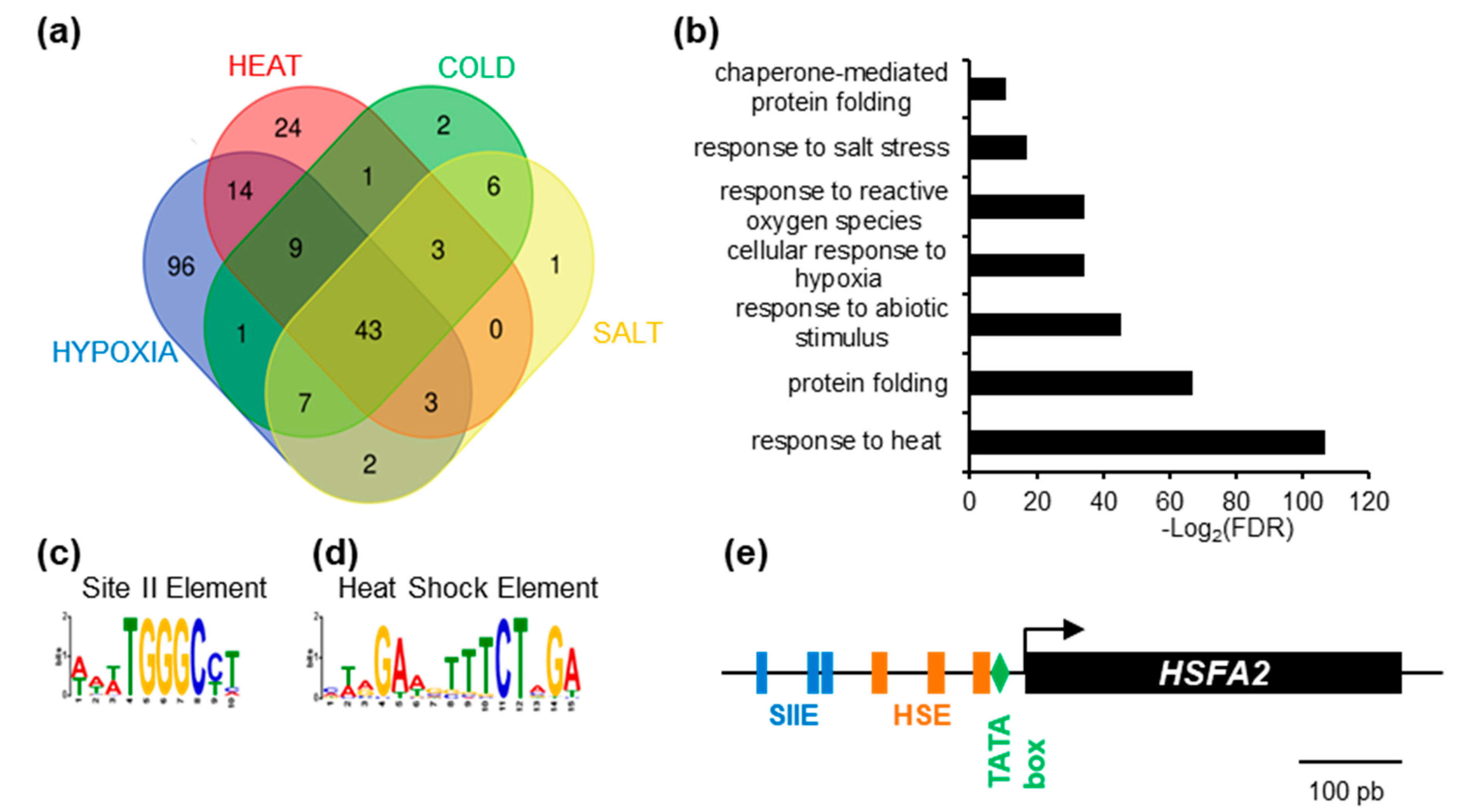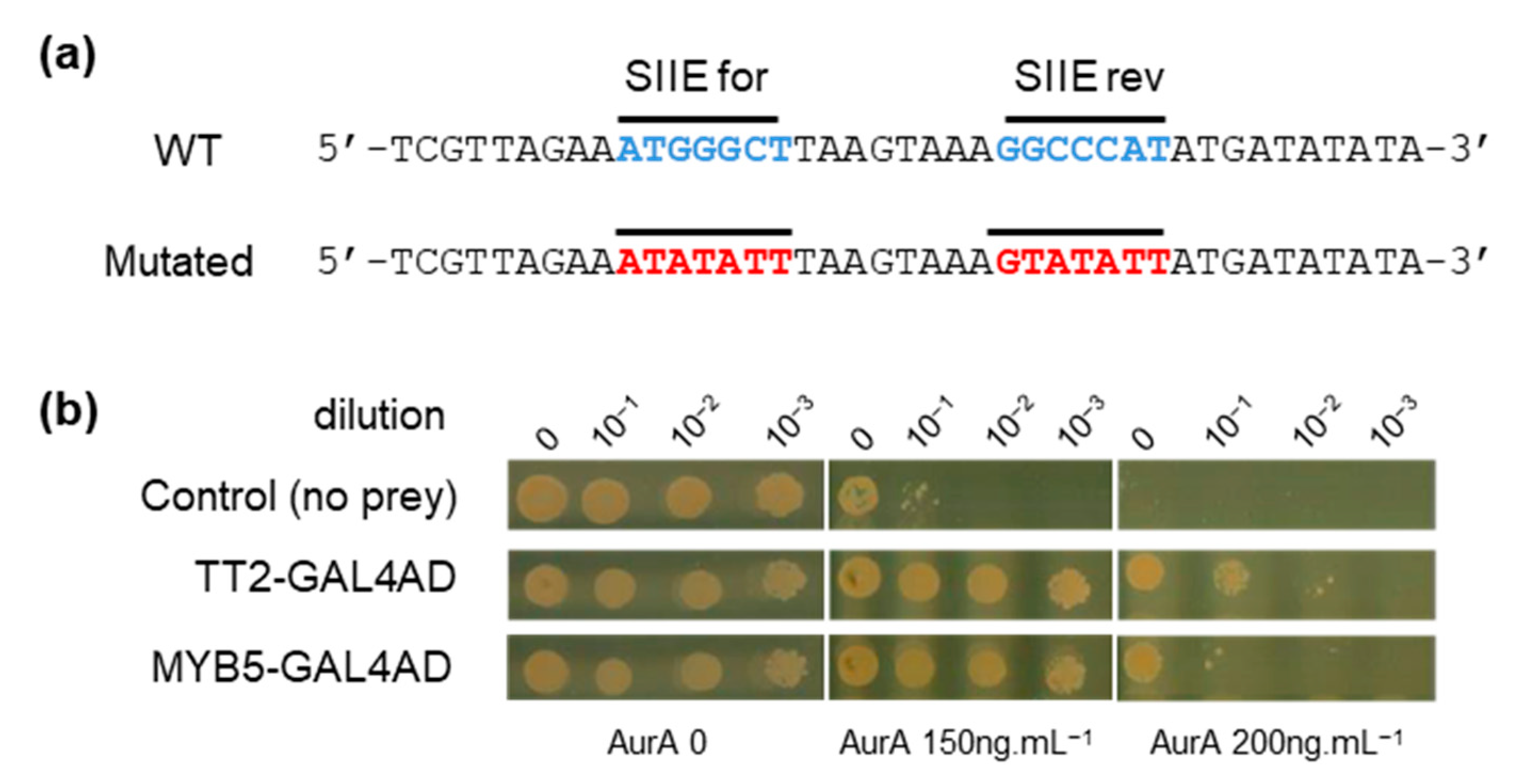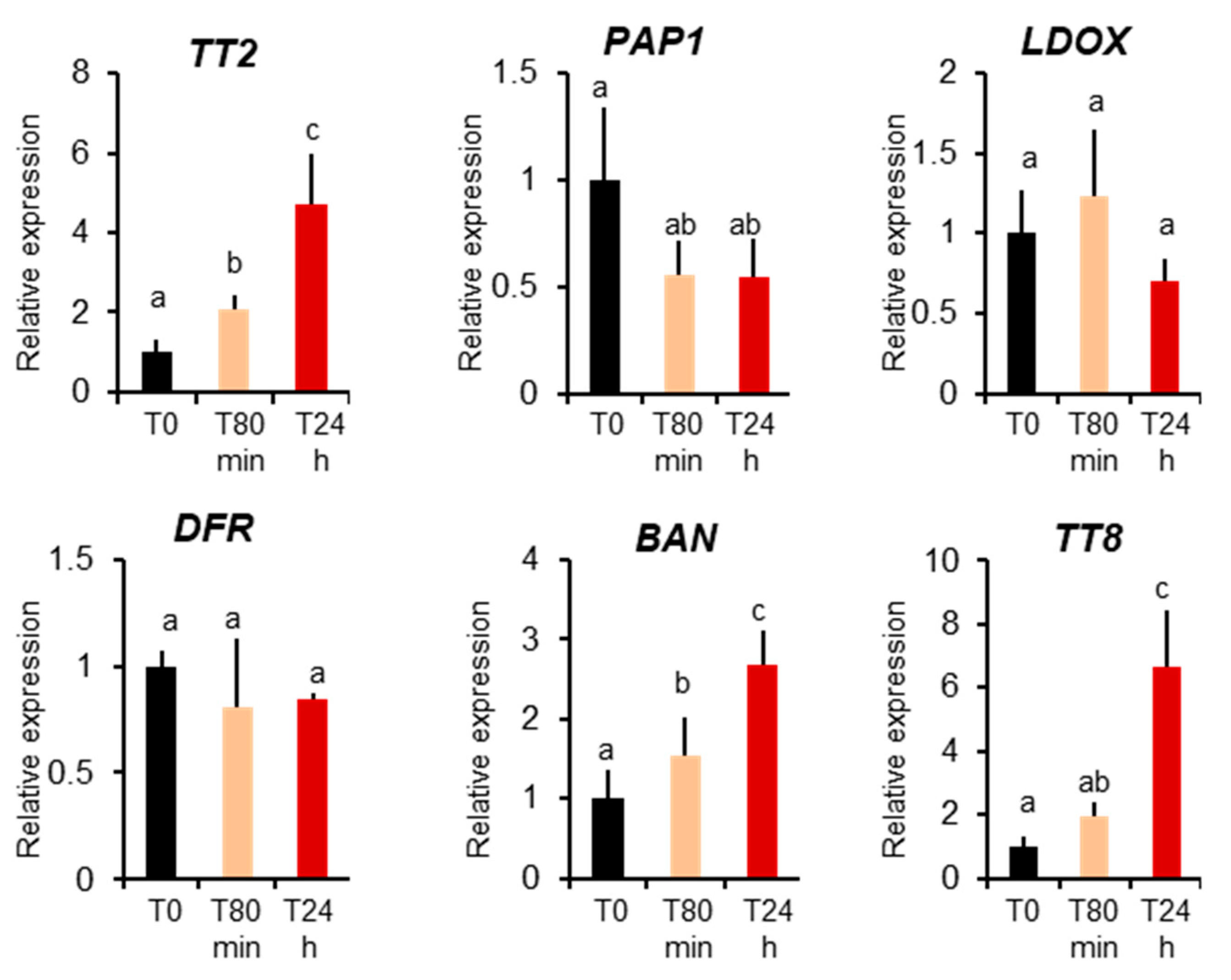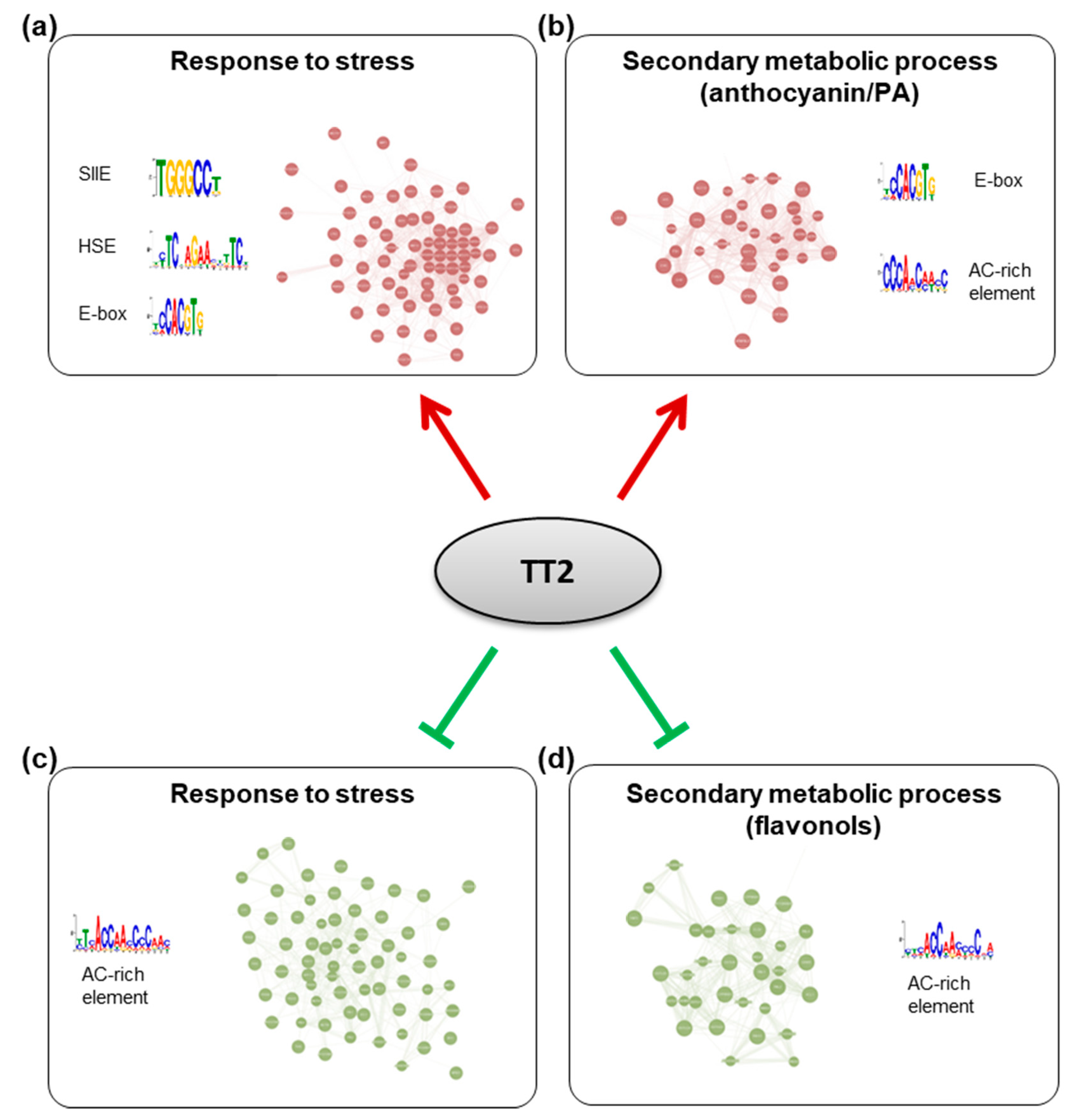The Seed Development Factors TT2 and MYB5 Regulate Heat Stress Response in Arabidopsis
Abstract
:1. Introduction
2. Materials and Methods
2.1. Plant Material
2.2. Bio-Informatic Analyses
2.3. Yeast One Hybrid
2.4. Plant Transformation
2.5. Transient Protoplast Transformation and Flow Cytometry
2.6. Heat Stress Resistance Assays
2.7. RNA Extraction and Q-PCR
2.8. RNA-Sequencing Transcriptomic Analysis
3. Results
3.1. Promoters of HSFA2 Coregulated Genes Are Enriched in the Site II Element Motif
3.2. TT2 and MYB5, Two Related R2R3-MYBs TFs, Bind to HSFA2 Site II Element in Yeast
3.3. TT2 or MYB5 Overexpression Induces HSFA2 Expression and Provides Stress Resistance in Planta
3.4. TT2, MYB5, TT8, and TTG1 Activate HSFA2 Expression via SIIE Motifs
3.5. The TT2/MYB5-MBW Complex Is Active in Vegetative Organs and Is Required for Heat Stress Resistance
3.6. TT2 and MYB5 Redundantly Regulate Stress Response Genes
3.7. TT2 Differentially Regulates Multiple Stress Response and Flavonoid Metabolism Genes
4. Discussion
4.1. Role of the TT2/MYB5 in the Plant Heat Stress Response
4.2. TT2/MYB5 in Stress Resistance Is Independent of Anthocyanin/PA Metabolism
4.3. TT2 Dual Modes of Transcriptional Regulation
Supplementary Materials
Author Contributions
Funding
Data Availability Statement
Acknowledgments
Conflicts of Interest
References
- Fragkostefanakis, S.; Simm, S.; Paul, P.; Bublak, D.; Scharf, K.-D.; Schleiff, E. Chaperone network composition in Solanum lycopersicum explored by transcriptome profiling and microarray meta-analysis. Plant Cell Environ. 2014, 38, 693–709. [Google Scholar] [CrossRef]
- Fragkostefanakis, S.; Mesihovic, A.; Simm, S.; Paupière, M.J.; Hu, Y.; Paul, P.; Mishra, S.K.; Tschiersch, B.; Theres, K.; Bovy, A.; et al. HsfA2 Controls the Activity of Developmentally and Stress-Regulated Heat Stress Protection Mechanisms in Tomato Male Reproductive Tissues. Plant Physiol. 2016, 170, 2461–2477. [Google Scholar] [CrossRef] [PubMed]
- Jacob, P.; Hirt, H.; Bendahmane, A. The heat-shock protein/chaperone network and multiple stress resistance. Plant Biotechnol. J. 2017, 15, 405–414. [Google Scholar] [CrossRef]
- Swindell, W.R.; Huebner, M.; Weber, A.P. Transcriptional profiling of Arabidopsis heat shock proteins and transcription factors reveals extensive overlap between heat and non-heat stress response pathways. BMC Genom. 2007, 8, 125. [Google Scholar] [CrossRef] [PubMed] [Green Version]
- Scharf, K.-D.; Berberich, T.; Ebersberger, I.; Nover, L. The plant heat stress transcription factor (Hsf) family: Structure, function and evolution. Biochim. Biophys. Acta Bioenerg. 2012, 1819, 104–119. [Google Scholar] [CrossRef]
- Hahn, A.; Bublak, D.; Schleiff, E.; Scharf, K.-D. Crosstalk between Hsp90 and Hsp70 Chaperones and Heat Stress Transcription Factors in Tomato. Plant Cell 2011, 23, 741–755. [Google Scholar] [CrossRef] [Green Version]
- Liu, H.-C.; Charng, Y.-Y. Common and Distinct Functions of Arabidopsis Class A1 and A2 Heat Shock Factors in Diverse Abiotic Stress Responses and Development. Plant Physiol. 2013, 163, 276–290. [Google Scholar] [CrossRef] [PubMed] [Green Version]
- Nishizawa, A.; Yabuta, Y.; Yoshida, E.; Maruta, T.; Yoshimura, K.; Shigeoka, S. Arabidopsis heat shock transcription factor A2 as a key regulator in response to several types of environmental stress. Plant J. 2006, 48, 535–547. [Google Scholar] [CrossRef]
- Ogawa, D.; Yamaguchi, K.; Nishiuchi, T. High-level overexpression of the Arabidopsis HsfA2 gene confers not only increased themotolerance but also salt/osmotic stress tolerance and enhanced callus growth. J. Exp. Bot. 2007, 58, 3373–3383. [Google Scholar] [CrossRef] [PubMed] [Green Version]
- Banti, V.; Mafessoni, F.; Loreti, E.; Alpi, A.; Perata, P. The Heat-Inducible Transcription Factor HsfA2 Enhances Anoxia Tolerance in Arabidopsis. Plant Physiol. 2010, 152, 1471–1483. [Google Scholar] [CrossRef] [Green Version]
- Nishizawa-Yokoi, A.; Nosaka, R.; Hayashi, H.; Tainaka, H.; Maruta, T.; Tamoi, M.; Ikeda, M.; Ohme-Takagi, M.; Yoshimura, K.; Yabuta, Y.; et al. HsfA1d and HsfA1e Involved in the Transcriptional Regulation of HsfA2 Function as Key Regulators for the Hsf Signaling Network in Response to Environmental Stress. Plant Cell Physiol. 2011, 52, 933–945. [Google Scholar] [CrossRef]
- Nesi, N.; Jond, C.; Debeaujon, I.; Caboche, M.; Lepiniec, L. The Arabidopsis TT2 Gene Encodes an R2R3 MYB Domain Protein That Acts as a Key Determinant for Proanthocyanidin Accumulation in Developing Seed. Plant Cell 2001, 13, 2099–2114. [Google Scholar] [CrossRef] [PubMed] [Green Version]
- Baudry, A.; Caboche, M.; Lepiniec, L. TT8 controls its own expression in a feedback regulation involving TTG1 and homologous MYB and bHLH factors, allowing a strong and cell-specific accumulation of flavonoids in Arabidopsis thaliana. Plant J. 2006, 46, 768–779. [Google Scholar] [CrossRef] [PubMed]
- Lepiniec, L.; Debeaujon, I.; Routaboul, J.M.; Baudry, A.; Pourcel, L.; Nesi, N.; Caboche, M. Genetics and biochemistry of seed flavonoids. Annu. Rev. Plant Biol. 2006, 57, 405–430. [Google Scholar] [CrossRef] [PubMed]
- Feyissa, D.N.; Løvdal, T.; Olsen, K.M.; Slimestad, R.; Lillo, C. The endogenous GL3, but not EGL3, gene is necessary for anthocyanin accumulation as induced by nitrogen depletion in Arabidopsis rosette stage leaves. Planta 2009, 230, 747–754. [Google Scholar] [CrossRef]
- Appelhagen, I.; Jahns, O.; Bartelniewoehner, L.; Sagasser, M.; Weisshaar, B.; Stracke, R. Leucoanthocyanidin Dioxygenase in Arabidopsis thaliana: Characterization of mutant alleles and regulation by MYB–BHLH–TTG1 transcription factor complexes. Gene 2011, 484, 61–68. [Google Scholar] [CrossRef]
- Xu, W.; Dubos, C.; Lepiniec, L. Transcriptional control of flavonoid biosynthesis by MYB–bHLH–WDR complexes. Trends Plant Sci. 2015, 20, 176–185. [Google Scholar] [CrossRef]
- Giraud, E.; Ng, S.; Carrie, C.; Duncan, O.; Low, J.; Lee, C.P.; Van Aken, O.; Millar, A.H.; Murcha, M.; Whelan, J. TCP Transcription Factors Link the Regulation of Genes Encoding Mitochondrial Proteins with the Circadian Clock in Arabidopsis thaliana. Plant Cell 2011, 22, 3921–3934. [Google Scholar] [CrossRef] [Green Version]
- Hruz, T.; Laule, O.; Szabo, G.; Wessendorp, F.; Bleuler, S.; Oertle, L.; Widmayer, P.; Gruissem, W.; Zimmermann, P. Genevestigator V3: A Reference Expression Database for the Meta-Analysis of Transcriptomes. Adv. Bioinform. 2008, 2008, 1–5. [Google Scholar] [CrossRef]
- Bailey, T.L.; Boden, M.; Buske, F.A.; Frith, M.; Grant, C.E.; Clementi, L.; Ren, J.; Li, W.W.; Noble, W.S. MEME SUITE: Tools for motif discovery and searching. Nucleic Acids Res. 2009, 37, w202–w208. [Google Scholar] [CrossRef]
- Castrillo, G.; Turck, F.; Leveugle, M.; Lecharny, A.; Carbonero, P.; Coupland, G.; Paz-Ares, J.; Oñate-Sánchez, L. Speeding Cis-Trans Regulation Discovery by Phylogenomic Analyses Coupled with Screenings of an Arrayed Library of Arabidopsis Transcription Factors. PLoS ONE 2011, 6, e21524. [Google Scholar] [CrossRef] [PubMed] [Green Version]
- Thevenin, J.; Dubos, C.; Xu, W.; Le Gourrierec, J.; Kelemen, Z.; Charlot, F.; Nogué, F.; Lepiniec, L.; Dubreucq, B. A new system for fast and quantitative analysis of heterologous gene expression in plants. New Phytol. 2011, 193, 504–512. [Google Scholar] [CrossRef] [PubMed]
- Kim, S.-J.; Tsukiyama, T.; Lewis, M.S.; Wu, C. Interaction of the DNA-binding domain of Drosophila heat shock factor with its cognate DNA site: A thermodynamic analysis using analytical ultracentrifugation. Protein Sci. 1994, 3, 1040–1051. [Google Scholar] [CrossRef] [PubMed] [Green Version]
- Ma, S.; Shah, S.; Bohnert, H.J.; Snyder, M.; Dinesh-Kumar, S.P. Incorporating Motif Analysis into Gene Co-expression Networks Reveals Novel Modular Expression Pattern and New Signaling Pathways. PLoS Genet. 2013, 9, e1003840. [Google Scholar] [CrossRef] [PubMed] [Green Version]
- Bernard, V.; Lecharny, A.; Brunaud, V. Improved detection of motifs with preferential location in promoters. Genome 2010, 53, 739–752. [Google Scholar] [CrossRef] [PubMed]
- Evrard, A.; Ndatimana, T.; Eulgem, T. FORCA, a promoter element that responds to crosstalk between defense and light signaling. BMC Plant Biol. 2009, 9, 2. [Google Scholar] [CrossRef] [PubMed] [Green Version]
- Trémousaygue, D.; Garnier, L.; Bardet, C.; Dabos, P.; Hervé, C.; Lescure, B. Internal telomeric repeats and ‘TCP domain’ protein-binding sites co-operate to regulate gene expression in Arabidopsis thaliana cycling cells. Plant J. 2003, 33, 957–966. [Google Scholar] [CrossRef]
- Hervé, C.; Dabos, P.; Bardet, C.; Jauneau, A.; Auriac, M.C.; Ramboer, A.; Lacout, F.; Tremousaygue, D. In Vivo Interference with AtTCP20 Function Induces Severe Plant Growth Alterations and Deregulates the Expression of Many Genes Important for Development. Plant Physiol. 2009, 149, 1462–1477. [Google Scholar] [CrossRef] [Green Version]
- Xu, W.; Grain, D.; Bobet, S.; Le Gourrierec, J.; Thévenin, J.; Kelemen, Z.; Lepiniec, L.; Dubos, C. Complexity and robustness of the flavonoid transcriptional regulatory network revealed by comprehensive analyses of MYB–b HLH–WDR complexes and their targets in A rabidopsis seed. New Phytol. 2014, 202, 132–144. [Google Scholar] [CrossRef]
- Gonzalez, A.; Mendenhall, J.; Huo, Y.; Lloyd, A. TTG1 complex MYBs, MYB5 and TT2, control outer seed coat differentiation. Dev. Biol. 2009, 325, 412–421. [Google Scholar] [CrossRef] [Green Version]
- Nakabayashi, R.; Yonekura-Sakakibara, K.; Urano, K.; Suzuki, M.; Yamada, Y.; Nishizawa, T.; Matsuda, F.; Kojima, M.; Sakakibara, H.; Shinozaki, K.; et al. Enhancement of oxidative and drought tolerance in Arabidopsis by overaccumulation of antioxidant flavonoids. Plant J. 2014, 77, 367–379. [Google Scholar] [CrossRef]
- Sharma, S.B.; Dixon, R.A. Metabolic engineering of proanthocyanidins by ectopic expression of transcription factors in Arabidopsis thaliana. Plant J. 2005, 44, 62–75. [Google Scholar] [CrossRef] [PubMed] [Green Version]
- Chen, M.; Wang, Z.; Zhu, Y.; Li, Z.; Hussain, N.; Xuan, L.; Guo, W.; Zhang, G.; Jiang, L. The Effect of TRANSPARENT TESTA2 on Seed Fatty Acid Biosynthesis and Tolerance to Environmental Stresses during Young Seedling Establishment in Arabidopsis. Plant Physiol. 2012, 160, 1023–1036. [Google Scholar] [CrossRef] [PubMed] [Green Version]
- Kelemen, Z.; Sebastian, A.; Xu, W.; Grain, D.; Salsac, F.; Avon, A.; Berger, N.; Tran, J.; Dubreucq, B.; Lurin, C.; et al. Analysis of the DNA-Binding Activities of the Arabidopsis R2R3-MYB Transcription Factor Family by One-Hybrid Experiments in Yeast. PLoS ONE 2015, 10, e0141044. [Google Scholar] [CrossRef] [PubMed] [Green Version]








| Identifier | Fold Change | Gene Description |
|---|---|---|
| Response to Stress | ||
| AT5G03720 | 1.57 | HEAT SHOCK TRANSCRIPTION FACTOR A3 (HSFA3) |
| AT3G51910 | 1.33 | HEAT SHOCK TRANSCRIPTION FACTOR A7A (HSFA7A) |
| AT3G24500 | 1.39 | MULTIPROTEIN BRIDGING FACTOR 1C (MBF1C) |
| AT3G16770 | 1.52 | ETHYLENE RESPONSE FACTOR 72 (ERF72) |
| AT5G59780 | 1.28 | MYB DOMAIN PROTEIN 59 (MYB59) |
| AT4G31800 | 1.46 | WRKY DNA-BINDING PROTEIN 18 (WRKY18) |
| AT5G52640 | 1.29 | HEAT SHOCK PROTEIN 90.1 (HSP90.1) |
| AT2G19310 | 1.27 | HSP20-like chaperones superfamily protein |
| AT5G51440 | 1.57 | HSP20-like chaperones superfamily protein |
| AT1G63750 | 1.55 | Disease resistance protein (TIR-NBS-LRR class) family |
| AT1G63860 | 1.42 | Disease resistance protein (TIR-NBS-LRR class) family |
| AT5G41740 | 1.45 | Disease resistance protein (TIR-NBS-LRR class) family |
| AT1G75830 | 3.04 | Plant defensin 1.1 (PDF1.1) |
| AT4G22212 | 1.41 | Encodes a defensin-like (DEFL) |
| AT2G43535 | 1.39 | Encodes a defensin-like (DEFL) |
| AT2G21490 | 2.24 | dehydrin LEA |
| AT2G47180 | 1.29 | Galactinol synthase 1 (GolS1) |
| AT4G11650 | 1.57 | OSMOTIN 34 (OSM34) |
| AT5G66400 | 1.32 | RESPONSIVE TO ABA 18 (RAB18) |
| Secondary Metabolic Process | ||
| AT1G71030 | 1.30 | MYB-LIKE 2 (MYBL2) |
| AT5G11260 | 1.39 | ELONGATED HYPOCOTYL 5 (HY5) |
| AT5G13930 | 2.15 | TRANSPARENT TESTA 4 (TT4) |
| AT5G42800 | 34.65 | DIHYDROFLAVONOL 4-REDUCTASE (DFR) |
| AT4G22880 | 6.34 | LEUCOANTHOCYANIDIN DIOXYGENASE (LDOX) |
| AT1G61720 | 451.56 | BANYULS (BAN) |
| Identifier | Fold Change | Gene Description |
|---|---|---|
| Response to Stress | ||
| AT5G08790 | −1.48 | ARABIDOPSIS NAC DOMAIN CONTAINING PROTEIN 81 (ANAC81) |
| AT5G06960 | −1.30 | TGACG MOTIF-BINDING FACTOR 5 (TGA5) |
| AT2G14610 | −30.09 | PATHOGENESIS-RELATED GENE 1 (PR 1) |
| AT2G17060 | −1.97 | Disease resistance protein (TIR-NBS-LRR class) |
| AT5G07390 | −1.64 | RESPIRATORY BURST OXIDASE HOMOLOG A (RBOHA) |
| AT5G08590 | −1.39 | SNF1-RELATED PROTEIN KINASE 2.1 (SNRK2.1) |
| AT1G55020 | −2.42 | LIPOXYGENASE 1 (LOX1) |
| AT2G37040 | −1.44 | PHE AMMONIA LYASE 1 (PAL1) |
| AT1G45145 | −1.49 | THIOREDOXIN H-TYPE 5 (TRX5) |
| AT1G05250 | −13.72 | PEROXIDASE 2 (PRX2) |
| AT5G51890 | −1.30 | PEROXIDASE 66 (PRX66) |
| AT2G38380 | −1.47 | Peroxidase superfamily protein |
| AT1G68850 | −1.80 | Peroxidase superfamily protein |
| AT5G64110 | −1.30 | Peroxidase superfamily protein |
| AT5G08670 | −1.35 | Encodes the mitochondrial ATP synthase beta-subunit |
| AT5G08680 | −1.35 | Encodes the mitochondrial ATP synthase beta-subunit |
| Secondary Metabolic Process | ||
| AT5G08640 | −1.72 | FLAVONOL SYNTHASE 1 (FLS1) |
| AT5G25980 | −2.88 | THIOGLUCOSIDE GLUCOHYDROLASE 2 (TGG2) |
| AT5G26000 | −1.35 | THIOGLUCOSIDE GLUCOHYDROLASE 1 (TGG1) |
| AT1G17170 | −1.47 | GLUTATHIONE S-TRANSFERASE TAU 24 (GSTU24) |
| AT1G17180 | −2.02 | GLUTATHIONE S-TRANSFERASE TAU 25 (GSTU25) |
| AT1G78340 | −1.54 | GLUTATHIONE S-TRANSFERASE TAU 22 (GSTU22) |
| AT1G51680 | −1.28 | 4-COUMARATE:COA LIGASE 1 (4CL1) |
| AT2G37040 | −1.44 | PHENYLALANINE AMMONIA LYASE 1 (PAL1) |
| AT3G10340 | −1.44 | PHENYLALANINE AMMONIA-LYASE 4 (PAL4) |
Publisher’s Note: MDPI stays neutral with regard to jurisdictional claims in published maps and institutional affiliations. |
© 2021 by the authors. Licensee MDPI, Basel, Switzerland. This article is an open access article distributed under the terms and conditions of the Creative Commons Attribution (CC BY) license (https://creativecommons.org/licenses/by/4.0/).
Share and Cite
Jacob, P.; Brisou, G.; Dalmais, M.; Thévenin, J.; van der Wal, F.; Latrasse, D.; Suresh Devani, R.; Benhamed, M.; Dubreucq, B.; Boualem, A.; et al. The Seed Development Factors TT2 and MYB5 Regulate Heat Stress Response in Arabidopsis. Genes 2021, 12, 746. https://doi.org/10.3390/genes12050746
Jacob P, Brisou G, Dalmais M, Thévenin J, van der Wal F, Latrasse D, Suresh Devani R, Benhamed M, Dubreucq B, Boualem A, et al. The Seed Development Factors TT2 and MYB5 Regulate Heat Stress Response in Arabidopsis. Genes. 2021; 12(5):746. https://doi.org/10.3390/genes12050746
Chicago/Turabian StyleJacob, Pierre, Gwilherm Brisou, Marion Dalmais, Johanne Thévenin, Froukje van der Wal, David Latrasse, Ravi Suresh Devani, Moussa Benhamed, Bertrand Dubreucq, Adnane Boualem, and et al. 2021. "The Seed Development Factors TT2 and MYB5 Regulate Heat Stress Response in Arabidopsis" Genes 12, no. 5: 746. https://doi.org/10.3390/genes12050746
APA StyleJacob, P., Brisou, G., Dalmais, M., Thévenin, J., van der Wal, F., Latrasse, D., Suresh Devani, R., Benhamed, M., Dubreucq, B., Boualem, A., Lepiniec, L., Immink, R. G. H., Hirt, H., & Bendahmane, A. (2021). The Seed Development Factors TT2 and MYB5 Regulate Heat Stress Response in Arabidopsis. Genes, 12(5), 746. https://doi.org/10.3390/genes12050746









